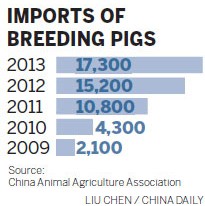

China's grain security is facing a challenge caused by excessive imports of breeding pigs, especially from North America and Europe, to enlarge their herds of swine.
Keen to resolve the problems caused by frequent shortages of pig products and rising pork prices in the 1990s, China began to import breeding pigs in large quantities into the domestic market in 2007. The number of foreign pig breeds has soared every year since.
The country imported 173,000 breeding pigs from the world market in 2013, up 13.8 percent from a year earlier and hit a new record, according to the General Administration of Customs. In the meantime, China also opened a new channel to allow large quantities of British pig semen into China this year.
However, in the hope of making quick money, the majority of pig farmers are inclined to put the pigs straight to work instead of making efforts such as quality checks and selective breeding to develop their businesses in a sustainable way.
"Despite the fact these foreign species can grow faster, have a better fat-to-meat ratio and yield higher returns compared with native species, their quality and future generations will decline. They cannot retain normal survival rates and fertility," said Wang Lianzeng, vice-president of the Beijing-based China Animal Agriculture Association.
Affected by the high mortality rates caused by nationwide crossbreeding, Wang said a sow's reproduction rate in China has declined from 16 piglets in 2006 to 14 last year, with two of them often dying when they grow to between 40 and 55 kilograms (pigs are normally slaughtered at a weight of around 60 to 80 kg in the UK). It costs pig farmers up to 420 kilograms of feed to get them to reach this weight, including feed for the sow and better quality nutrition for piglets.
In contrast to China, the average reproduction rate for a sow is more than 20 annually in the United States and Denmark.
This has forced China to maintain a cultivation scale of 50 million sows per year to ensure pork supply and demand are in balance, according to a report by the college of animal sciences and technology at Wuhan-based Huazhong Agricultural University.
"Based on this figure, such a low cultivation rate can waste 20 million metric tons of grain-based feed in China every year. The wasted grain is equal to one year's basic rations for 75 million Chinese residents," said Wang.
China mainly purchases five types of breeding pigs, including the Large White, Duroc and Berkshire from the US, Canada, Denmark, France and the UK every year.
Chen Jie, a researcher at the research center for the rural economy of the Ministry of Agriculture, said the diet structure of foreign breeding pigs is heavily based on large-scale feeding systems and high-protein feed made from corn, soybean and fishmeal. They cannot get used to the dispersed feeding method that includes corn-based starch and roughage feed and excessive use of additives conducted by Chinese pig farmers within a short period.
"Chinese pig keepers must be aware that imported breeding pigs are only capable of raising infertile offspring and producing processing meat. They have to purchase a large amount of costly high-protein grain feed every day to run their businesses," Chen said. "Another fact they should realize is China's grain prices have remained high in recent years while the government is trying hard to ensure its grain security."
China's pork production amounted to 54.93 million tons in 2013, a 2.8 percent rise from a year earlier, data from the National Bureau of Statistics shows. It makes it the world's biggest pork producer and consumer. To tackle food inflation, the nation's pork imports totaled 584,000 metric tons last year, a notable 12 percent increase from 2012.
Yu Chuanzhou, a professor at Huazhong Agricultural University, said Chinese native pigs are gradually disappearing. Native species account for around 10 percent of the 50 million sows in China.
The research work by the Ministry of Agriculture survey from 2004 to 2008 discovered four breeds, including the Shenxian in Hebei province and the Xiangcheng in Henan province, have already disappeared.
To avoid extinction and develop native species, the Chinese government has placed 34 species under State-level protection, which means they cannot be slaughtered.
The red-hot domestic pork trading market has also driven capable Chinese companies to secure pork supplies from the global market, Chinese pork producer Shuanghui International Holdings Ltd, a subsidiary of Luohe-based Shuanghui Group, completed a $4.7 billion purchase of US pork giant Smithfield Foods Inc last year, the largest Chinese acquisition of a US company.
Stop pork from becoming easy meat
2014-04-28China announces pork purchase scheme
2014-02-20Duck, pork found in Beijing mutton
2013-08-22Shuanghui acquires world's largest pork processor
2013-05-30Pork price rebounds after government boost
2013-05-23Copyright ©1999-2018
Chinanews.com. All rights reserved.
Reproduction in whole or in part without permission is prohibited.